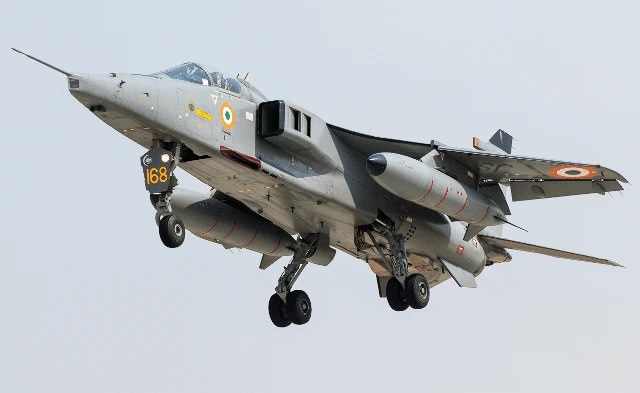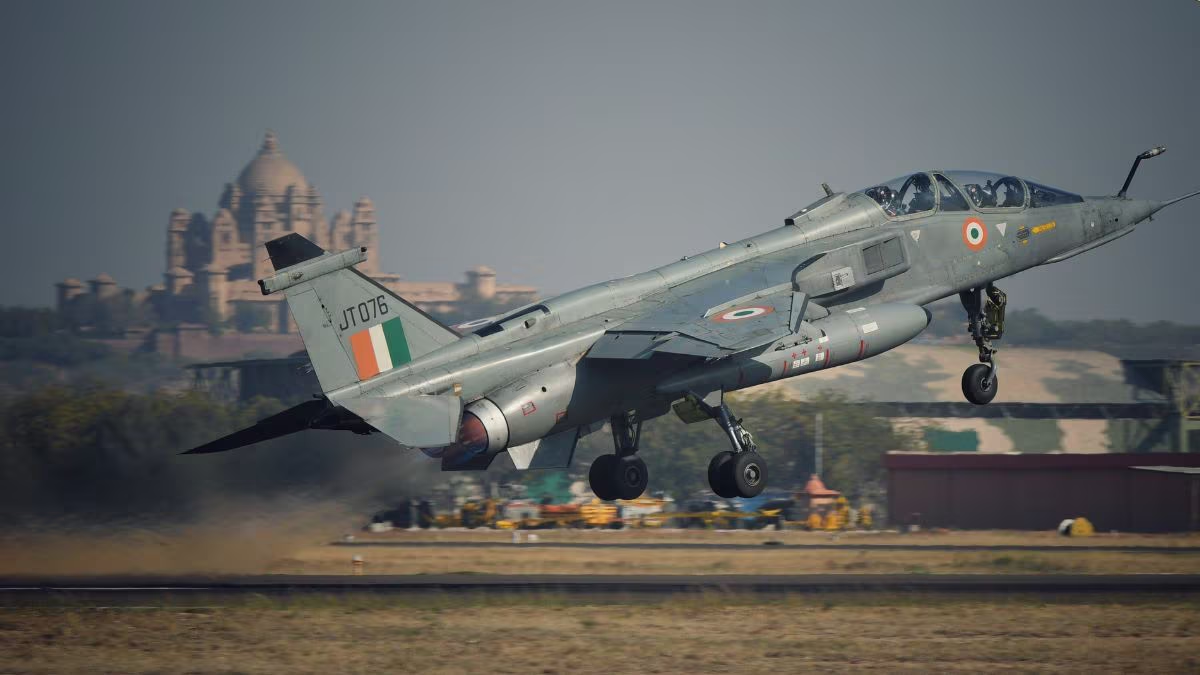The SEPECAT Jaguar is a twin-engine, ground-attack aircraft that has played a crucial role in the Indian Air Force (IAF) for over four decades. Designed for deep penetration strike missions, the Jaguar has earned its reputation as one of the most reliable fighter jets in the IAF’s arsenal.

Jaguar Fighter Jet Introduction
The Jaguar is a product of Anglo-French collaboration between British Aircraft Corporation (UK) and Dassault Aviation (France) under the joint venture SEPECAT. Originally built as a trainer aircraft, it evolved into a powerful all-weather tactical strike aircraft.
- Type: Twin-engine, ground-attack aircraft
- Role: Deep penetration strike, close air support, reconnaissance
- Introduced in IAF: 1979
- Manufacturer: HAL (India, under license)
- NATO Name: Jaguar
Technical Specifications of Jaguar Fighter Jet
| Feature | Details |
|---|---|
| Crew | 1 (pilot) |
| Engines | 2 × Rolls-Royce Turbomeca Adour |
| Maximum Speed | ~1,350 km/h (Mach 1.3) |
| Range | 800 km combat radius |
| Ferry Range | Up to 3,500 km with drop tanks |
| Service Ceiling | 46,000 ft |
| Armament | Guns, bombs, missiles, rockets |
| Avionics | Upgraded radar, laser-guided systems |
Jaguar Fighter Jet in Indian Air Force (IAF)
The Indian Air Force inducted the Jaguar in 1979 to boost its deep strike capabilities, especially in response to threats from neighboring countries. The aircraft was licensed to be produced by Hindustan Aeronautics Limited (HAL) in Bengaluru.
Roles Performed in IAF:
- Ground attack missions
- Nuclear delivery capability
- Reconnaissance missions
- Maritime strike roles
The Jaguar fleet in India includes variants like:
- Jaguar IS (Strike)
- Jaguar IB (Trainer)
- Jaguar IM (Maritime strike)
- Jaguar DARIN III (Upgraded avionics and weapons system)
Upgrades: DARIN III Standard
The IAF has upgraded several Jaguars under the DARIN (Display Attack Ranging Inertial Navigation) program. The latest DARIN III standard brings:
- AESA radar
- Modern cockpit with glass displays
- Advanced electronic warfare systems
- Capability to fire smart bombs and precision-guided munitions
This upgrade extends the aircraft’s service life and effectiveness well into the late 2020s.
Weapons and Armament
The Jaguar can carry a wide variety of weapons depending on the mission profile:
- 2× 30mm Aden cannons
- Laser-guided bombs (LGBs)
- Cluster bombs and dumb bombs
- Air-to-surface missiles
- Anti-ship missiles (Sea Eagle)
- Drop tanks and electronic pods
The aircraft’s strong payload and long-range capability make it ideal for surgical strikes and offensive missions.
Jaguar Fighter Jet Operational History & Combat Usage
Though the Jaguar hasn’t seen major war action in India, it has been used extensively in:
- Kargil War (1999): Jaguars conducted high-altitude reconnaissance and strike missions.
- Training and deterrence missions along the western border.
- Regular participation in joint military exercises with nations like the UK, US, and France.
Globally, Jaguars have been used in conflicts like the Gulf War (by the UK and France), proving their battle-worthiness.
Why Jaguar Fighter Jet Still Matters in Modern Warfare
Despite being over four decades old, the Jaguar remains relevant because of:
- Upgraded avionics
- High payload capacity
- Low-level strike capability
- Strategic deterrence value
While newer jets like the Rafale, Tejas, and Sukhoi Su-30MKI are more advanced, the Jaguar complements them by specializing in ground-attack roles.
Is Jaguar Fighter Jet Being Replaced Soon?
Yes, the IAF is planning to gradually phase out the Jaguars by 2032. Replacement discussions include:
- Indigenous Tejas Mk2
- AMCA (Advanced Medium Combat Aircraft)
- Foreign platforms as part of the Multi-Role Fighter Aircraft (MRFA) program
Until then, the upgraded DARIN III Jaguars will continue to serve key strategic roles.
Interesting Facts about the Jaguar Jet
- Nicknamed “Shamsher” in India.
- Can operate from semi-prepared runways and hot, high-altitude airfields.
- Equipped to deliver nuclear weapons (if needed).
- Despite age, it’s one of the stealthiest in radar profile among IAF jets.
Conclusion
The Jaguar fighter jet may be aging, but with its upgrades, payload, and strike capability, it remains a formidable asset in the Indian Air Force. As India moves toward a future of indigenous defense production, the Jaguar reminds us of the legacy of powerful partnerships, engineering, and air dominance.
Its retirement will mark the end of an era, but its contribution to India’s air power story will never be forgotten.
More For You
1.Capgemini Acquires WNS for $3.3 Billion to Lead in Intelligent Operations
2.How AI Code Assistants Are Redefining Software Development

